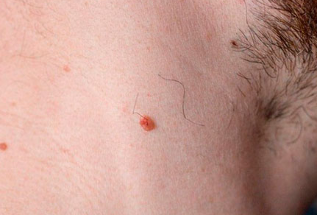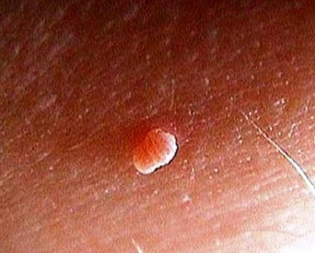Non-standard proliferation of skin cells called tumors. As the main reason for the appearance of tumors are referred to specialists exposure to ultraviolet rays.

The second cause lesions of the skin are carcinogens. For any emergent formation on the skin, it is necessary to monitor and to promptly contact a doctor — oncologist.
It will all the necessary diagnostic procedures. And he will recommend what further actions you will need to perform.
Papilloma, warts, and warts – all this is a consequence of the activity of the human papillomavirus or HPV. The virus enters the human body, and a long time inactive. Under the influence of precipitating factors is the activation of HPV. This is manifested by the formation of soft growths on the skin and mucous membranes.
The neoplasm may impair the quality of life, its peculiar mutating cells leading to cancer. Timely diagnosis and treatment of papillomas genital organs – the key to a healthy and fulfilling intimate life of a woman.
Causes of papilloma in mouth
The main cause growths in the mouth is the presence in the body of human papillomavirus. To get it easily: the virus is transmitted through everyday life and through personal contacts (touching, unprotected sex). The main ways of infection:
- Failure to observe the rules of personal hygiene, using other people's toothbrushes and towels;
- Household way is to poor disinfection of objects and utensils that are shared with an infected person;
- Personal contact with a virus carrier (kissing, oral sex, sexual intercourse);
- Infection of the newborn occurs during passage through the birth canal from a mother who is a carrier of HPV.
The incubation period of the disease may last for several years. To detect HPV is by testing.
There are a number of factors influencing the activation of the virus and the appearance of symptoms:
- Frequent colds and chronic inflammation, decreased immunity;
- Stressful lifestyles and bad habits;
- Hormonal disturbances;
- Long antibiotics and corticosteroids (hormonal preparations);
- Diseases of the gastrointestinal tract;
- Pregnancy;
- Systematic injury to the oral mucosa (use a toothbrush with stiff bristles, hot food and drink, dentures, braces);
- Caries, periodontal disease, gingivitis.
Any papilloma appeared on the body, caused solely by HPV (the human papillomavirus). Warts on the intimate places – the widespread phenomenon. The growths are in the groin, in the vagina, on the penis, in the anus. Often genital HPV is common among children. Tumors can deliver their medium not only embarrassment, but also physical discomfort. According to medical statistics, HPV genital organs found in almost a quarter of the population.
The mechanism of formation of papillomas in the intimate area
Inactive genital human papillomavirus can live in the body for quite a long period. The virus can infect others, completely unaware about it.
The revitalization and growth of viral cells occurs with the weakening of protective forces of an organism. The result is the appearance of tumors.
Contrary to popular belief that the papilloma is causing discomfort only in cosmetic terms, it can provoke health problems.
Types of HPV
According to the international standards all tumors are divided into three types:
- Benign.
- Malignant.
- Borderline (pre-cancerous).
It is important to determine the type of warts on the body. The type of neoplasm depends on the strain of the virus.
In most cases, people are faced with non-dangerous forms of infection that are not harmful to health and cause only aesthetic discomfort. It is sufficient to remove a wart is to forget about the discomfort.
To distinguish different types of warts on the body simply by comparing different photos. Each of the formations is characterized by several features, knowing that it is easy to suspect some form of the disease.
Common papilloma or vulgar warts
The most common manifestation of HPV is common warts, popularly called warts. They are caused by multiple strains of the virus that are easily transmitted contact-household and sexually.
According to statistics, approximately every third person on the planet at least once in life faced with the appearance of common warts.
Papillomas in the mouth there are several types:
- Epithelial hyperplasia is a small education in the form of papillae, often formed on the sides of the tongue;
- Ordinary (vulgar) papilloma appears in the sky and has the shape of flattened cones;
- Vulgar papilloma;
- Growths in the gums are most often presented in the form of a flat papilloma;
- Flat papillomas;
- Filiform papillae have a thin base, which often causes bleeding and inflammation, if they are hurt. Meet at the bridle of the tongue;
- Filiform papillae on the tongue;
- Genital warts have the shape of a cone, are joined together and form large lesions;
- Genital papilloma

Important! Late diagnosis threatens the growth of papillomatous nodes on the mucous membranes of the respiratory tract.
Papilloma on the tongue and cheek may have a different shape. Polyps on the cheek, consists of a small soft lump and does not hurt. Growths on the tongue are prone to irritation and micro-trauma that can cause bleeding.
Papilloma on tonsil is often confused with laryngitis or purulent tonsillitis. Because of swelling you may experience swelling of the Airways and vocal cords that causes difficulty breathing.
Unpleasant feelings accompany the process of absorption of food even liquid. Sometimes the person experiences the feeling of presence of a foreign body in the throat.
The appearance of papillomas of the larynx may be accompanied by changes of voice, with breathing problems. While taking solid food mucous growths may bleed. Red throat in a child may indicate the presence of growths. Papillomatosis of larynx in children is the cause of bronchitis.
The appearance of pathological formations in the form of a lump or polyp on the gums (growths on the gums) the risk that the mucosa is injured with a toothbrush or dentures. Ultimately, this will lead to inflammation and infection non-healing ulcers.
Papillomavirus, in addition to skin changes, carries risk for the development of various diseases. Type of infection shows how it will develop and the risks posed.
The determination of the kind of warts you need to:
- identify whether there is a risk of degeneration of the tumor as a malignant tumor;
- selecting effective treatment;
- determine the type of infection.
Simple
Also known as vulgar or ordinary. The formation of papillomas is preceded by a slight burning sensation.
Eventually there is a round lump resembling a tumor. Still later, the smooth surface of the tumors changed to rough, and the color of flesh becomes more dark.
Sizes can vary from 1 to 10 mm.
Often common warts appear between the toes and on the palms from the rear. Children mostly move on all fours, can be localized on the knees. There are single and multiple.
Often vulgar warts are not dangerous to human health, presenting a benign growths.
Plantar
The name itself speaks about the localization of papillomas. To not mistakenly confuse them with calluses, there are a number of talking signs:
- the tumor by all indications resembles an ordinary wart;
- pain is felt in the field build-up when wearing the shoes of a small size;
- skin pattern is not present and the surface is rough.
Plantar verrucas are inherent to the mosaic papillomatosis when near primary cutaneous formations are formed bubbles with time, papillomas.
In small children plantar warts can disappear on their own.
Flat
Have oval, stretched, and rarely a round shape. Characterized by a slight height by a few millimeters protrude above the skin. Strike the face, the skin of the upper portion of the rib cage, sometimes the external sexual organs.
Color is slightly darker flesh tone. Nearby flat papillomas tend to unite into a single spot, and then become much more noticeable.
Threadlike
Warts, characterized by a specific leg and the longitudinal shape are called filiform (acrochordus). Initially, the cutaneous lesion has the appearance of small bumps that soon in the sky.
It's most common in men and women after 40 years. Localized on the neck, on the eyelids of the eyes, under the arms, in the groin area, near the breast. Often injured due to the presence of thin legs, which can be easily damaged by wear or sloppy movement.
Pointed
Resemble the papillary formations. Can affect the skin both singly and in droves. With the development of connecting the dots, forming a Nude or bright pink comb.
The appearance of genital warts caused by infection transmitted through sexual contact. In this regard, warts are striking genitals, groin area, the area near the anus.

Genital papillomas develop very quickly within a few days and can occupy a large portion of healthy tissue. Even after a successful treatment a relapse is not excluded.
Medicine has more than a hundred varieties of HPV. About forty of them are sexually transmitted, and accordingly affects the genitals of both men and women, many types of HPV do not pose harm, some are particularly dangerous and can cause cancer.
Types of human papilloma virus is commonly classified according to the degree of the probability of oncogenic formations on the skin. Distinguish:
- a particularly dangerous type 16, 18, 36, 45;
- type medium-high hazard– 31, 33, 35, 51, 52, 58;
- safe type– 6, 11, 42, 43, 44.
HPV is a pathogen, with up to hundreds of stamps. Depending on the species, influencing the person stamp of HPV on the skin are formed and different types of papillomas. They differ in appearance, growth rate, location on the body.
Some papillomatous growths are detected in the mucous membranes of the oral cavity, bladder, in women, the vagina, and men in the area of the penis.
The definition of a papilloma it is necessary to select the most effective method of treatment and to assess the risk of the degeneration of this tumor is malignant.
Conventional medicine divides HPV into 4 groups:
- non-oncogenic;
- low-oncogenic;
- bearing medium oncogenic risk;
- different high carcinogenicities.
Non-oncogenic, i.e., do not transform over time into a cancerous tumor, as a rule, are papillomas vulgar, flat, and plantar types. If you take the General definition of papilloma, in Latin, can be described her as "a tumor of the papilla".























